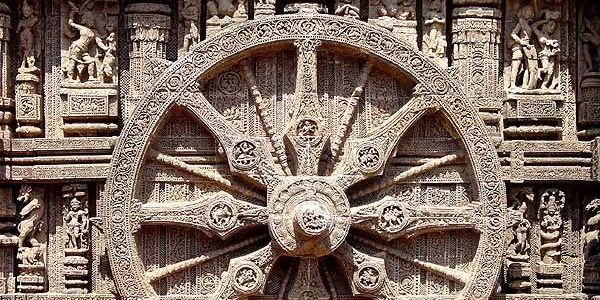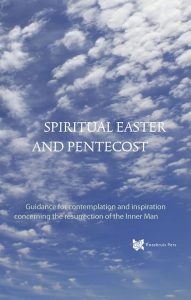TUESDAY BEFORE EASTER
THE MYSTERY OF LIFE AND DEATH
“Master, when a man dies, will he live again?”
This essential question of life is the beginning of a conversation about the resurrection between Jesus and his disciples as described in chapter 69 of The Gospel of the Holy Twelve.
Many visions of life, birth and death circulate among human beings. Supporters of the materialistic principle, which states that the human consciousness is a result of physical processes, are convinced that death is the absolute end and that there is nothing after death.
Most religions assume that after death life continues in a different form, the quality of it having been determined by actions in earthly life. Sometimes three spheres are identified in this afterlife: hell, purgatory and heaven.
There is also the vision that is related to the concept of reincarnation, by which is usually meant that the consciousness or soul of a deceased one connects itself over time with a transitory human child born from a similarly transitory mother.
In addition to these visions there is the gnostic Christian vision as expressed by Jesus in chapter 69 of The Gospel of the Holy Twelve. Here he speaks to his disciples, of whom it can be said that they have ears to hear and receptive minds. However, outsiders experienced the reasoning of Jesus as a collection of dark sayings.
“Master, when a man dies, will he live again?” The beginning of Jesus’ answer is: ”I am the resurrection and the life, I am the Good, the Beautiful, the True; if a man believes in Me, he shall not die, but live eternally. As in Adam all die, so in the Christ shall all be made alive.”
If we were to take this answer literally, it would be a very unjust answer. Then people who do not believe in Jesus because they grew up without religion or in a religion other than Christianity for example, would not be able to participate in the new life.
However, if we understand this language as the mystery language, in which Jesus’ words ‘I’ and ‘me’ do not refer to his own person but to the inner Christ present in every human being, then the answer receives its actual meaning. The inner Christ is the immortal divine principle located near the heart, also referred to as the divine spark, the spirit-spark, the primordial atom, the pearl, the rose and the jewel in the lotus.
In the majority of humanity the immortal Christ principle is not yet active or only in a very limited way. It is as if it were dead, latent, but it can rise from death and bring about new life in which the good, the beautiful and the true will simultaneously start to manifest themselves harmoniously.
The person who, out of sheer life experience, no longer fully identifies himself with his mortal personality but becomes aware of the immortal Christ principle within himself will start to listen more carefully to its impulses. And based on that ‘faith in Christ’ he, the inner Christ, will not die but will live eternally.
When his time comes, the physical man dies; but the soul body which emerged from the spirit-spark remains alive.
Eventually, every human being is called to go this spiritual path of resurrection, when his or her right moment has come. This is expressed in the statement, “Just as in Adam all die, so in the Christ shall all be made alive again.”
What is meant here by “in Adam all die”?
Adam is the name of the original, divine, non-physical person who was greater, more powerful and more magnificent than the material being that we now call ‘man.’ Adam was allowed to work in the Garden of the Gods in order to gain awareness and to learn how the laws of this divine world function. This man Adam was a very small reflection of the cosmos, a microcosm therefore, carrying the divine spark of the Christ principle in its centre.
The paradise myth from the Book of Genesis tells us that Adam did not obey the divine laws of paradise and therefore had to leave. Then God made ‘coats of skin’ for Adam and his wife Eve, meaning that they received physical bodies of flesh and blood. From that moment on they were living in a region of much coarser matter, where everything moves back and forth between two poles and is subject to the law of rising, shining and fading.
This fall from paradise we can see as the death of Adam, the original divine being. Seen from the divine realm there is no real life in our world, but only a biological ‘existence’. The immortal human systems – the microcosms – which we now inhabit as mortal personalities, once died in Adam, meaning that they descended into a field of coarse matter.
Fulfilling our inner mission means revivifying our ‘dead’ microcosm on the basis of the Christ principle in our heart. Therefore it is said: “As in Adam all die, so in the Christ shall all be made alive.” The point is that our microcosm will become perfect again, based on the blueprint that is contained in the Christ principle in the centre of the microcosm. In chapter 69 of The Gospel of the Holy Twelve, we read further:
Blessed are the dead who die in me and are made perfect in my image and likeness, for they rest from their labours and their works do follow them. They have overcome evil and are made Pillars in the Temple of my God; and they go out no more, for they rest in the Eternal.
For them who have done evil, there is no rest, but they go out and in and suffer correction for ages until they are made perfect. But for them who have done good and attained unto perfection, there is endless rest and they go into life everlasting. They rest in the Eternal.
Over them the repeated death and birth have no power; for them the wheel of the Eternal revolves no more, for they have attained unto the Centre where is eternal rest, and the centre of all things is God.
The Gospel of the Holy Twelve 69: 2-4
In this part of the Gospel it is made clear that a fallen microcosm is tied to what is known as the wheel of birth and death. The immortal microcosm repeatedly receives a new mortal personality as inhabitant. The results of the lives of all those personalities together form a treasure of life experiences that are stored in the microcosm.
This cycle of being born again and dying again is broken when finally a personality in the microcosm ‘chooses the right thing’, meaning that he begins the work to restore the microcosm on the basis of the inner Christ. Then the restored microcosm enters once again into the state of the original eternal life.
With eternal life is not meant here an infinite amount of time but an entirely new dimension beyond time and space, which is called the heavenly kingdom. About entering into this entirely new state of life, Jesus speaks:
“If you do not make the below as the above, and the left as the right, and the behind as the before, entering into the Centre and passing into the Spirit, you shall not enter into the Kingdom of God.”
The Gospel of the Holy Twelve 69: 5
This quote is again written in veiled language and cannot be understood without the proper key. Seven directions are indicated: up, down, left, right, rear, front and centre. In this description we can recognise the three-dimensional cross in which three aspects are perpendicular to each other. However, this mystery language does not refer to physical directions but to symbolic directions.
Symbolically speaking, ‘above’ means close to the divine origin. Symbolically ‘down’ means further away from the divine origin. In order to enter into the kingdom it is necessary to make that which is below equal to that which is above. This means that it is up to the personality to attract ‘spiritual energies’ from ‘above’ by means of focussing on ‘what is above’ in order to purify himself, up to and including the physical body, thus realising the resurrection body within himself.
Symbolic ‘left’ stands for the receptive, the passive, yin, the feminine. Symbolic ‘right’ represents the creative, the active, yang, the masculine. Only in the harmonious, yet dynamic, balance between left and right, between the receiving and the creating, between yin and yang, between inhalation and exhalation, the kingdom can be entered. The polarising and destructive effect of this world will then be transformed into a connecting and creative force.
Symbolic ‘behind’ refers to the path that the microcosm has finished throughout many lives as well as to the experiences that were gathered. Symbolic ‘front’ refers to the path that lies ahead of him, the future. To equalise that which is behind to that which is in front means that the human being accepts the life experience of the microcosm, his karma, as a guiding force in his life. He determines his consciousness to the current now, neither speculating nor projecting anything in the future but accepting the path that lies invisibly ahead of him.
These acts can never be forced or taught. They can only then be liberating when they emanate from the hidden source, the seventh direction which lies in the middle: the centre, the divine spark, the Christ principle. That is why Jesus says:
If you do not make the below as the above, and the left as the right, and the behind as the before, entering into the Centre and passing into the Spirit, you shall not enter into the Kingdom of God.
The Gospel of the Holy Twelve 69:5

